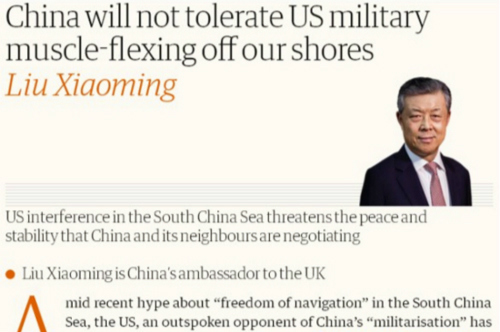
2018年6月27日,英国主流大报《卫报》网络版刊登驻英国大使刘晓明题为《中国不容美国在南海“秀肌肉”》的署名文章。全文如下:文章源自英文巴士-https://www.en84.com/5425.html
文章源自英文巴士-https://www.en84.com/5425.html
On 27 June 2018, the website of The Guardian published a signed article by Ambassador Liu Xiaoming entitled “China will not tolerate US military muscle-flexing off our shores”. The full text is as follows:文章源自英文巴士-https://www.en84.com/5425.html
文章源自英文巴士-https://www.en84.com/5425.html
中国不容美国在南海“秀肌肉”文章源自英文巴士-https://www.en84.com/5425.html
China Will Not Tolerate US Military Muscle-Flexing off Our Shores文章源自英文巴士-https://www.en84.com/5425.html
文章源自英文巴士-https://www.en84.com/5425.html
最近,一些人热衷炒作南海“航行自由”问题。美国一边鼓噪所谓反对南海“军事化”,一边频繁派军用舰机到南海“秀肌肉”。为了拨云见日、澄清真相,我认为有必要搞清楚四个问题:文章源自英文巴士-https://www.en84.com/5425.html
文章源自英文巴士-https://www.en84.com/5425.html
Amid recent hype about “freedom of navigation” in the South China Sea, the US, an outspoken opponent of China’s “militarisation” has been flexing its own military muscle by sending naval vessels and aircraft carriers to the region. Four questions need to be answered to clarify the real situation.文章源自英文巴士-https://www.en84.com/5425.html
第一,什么是航行自由?
根据包括《联合国海洋法公约》在内的国际法,一国船舶在另一国领海内行使航行自由,必须符合“无害通过(Innocent Passage)”标准,即不得使用或威胁使用武力,不得进行军事演习、搜集情报等行动。《公约》对外国军舰是否享有“无害通过”权未作明确规定,但世界上很多国家都要求外国军舰进入本国领海应获得批准或事先通知,比如中国在1992年《领海及毗连区法》就作出了相关规定。
First, what is freedom of navigation? According to international law, ships navigating in the territorial waters of countries other than their own must meet the “innocent passage” requirements of the United Nations Convention on the Law of the Sea (UNCLOS). That means not using force or threatening the use of force, and not engaging in military exercises or intelligence gathering. Although naval ships are not subject to UNCLOS provisions of innocent passage, they are required by many countries to obtain prior permission or provide advance notice to enter foreign territorial waters. Such is the provision of China’s Law on the Territorial Sea and the Contiguous Zone.
航行自由并不是绝对的“自由航行”。美国提出的所谓“航行自由行动”与国际法上公认的航行自由不能混为一谈。“航行自由行动”是美国为其在世界各地“横行”提供的理由,这是对国际法的曲解和滥用,是彻头彻尾的“横行自由”。
So, freedom of navigation is not an absolute freedom to sail at will. The US Freedom of Navigation Programme should not be confused with freedom of navigation that is universally recognised under international law. The former is an excuse to throw America’s weight about wherever it wants. It is a distortion and a downright abuse of international law into the “freedom to run amok”.
第二,南海航行自由存在问题吗?
中国与部分周边国家在南海的确存有一些争议,但维护南海地区稳定是各国共识。在各国努力下,南海局势总体保持稳定。南海每年十几万艘商船穿梭往来,从未有哪一艘遇到过航行自由问题。
Second, is there any problem with freedom of navigation in the South China Sea? The reality is that more than 100,000 merchant ships pass through these waters every year and none has ever run into any difficulty with freedom of navigation. Despite some disputes between China and some of its neighbours, maintaining stability in the South China Sea has been a matter of consensus for all the countries in this region. The overall situation has been stable, thanks to the joint efforts of all the regional partners.
去年8月,中国与东盟国家外长共同通过了“南海行为准则”框架。各方还商定于今年内至少再举行3次磋商。在这样风平浪静、和谐稳定的气氛中,所谓航行自由更成为一个“伪命题”。个别国家炒作南海航行自由问题,要么是为自己的军舰进入南海“挑事”找借口,要么就是蓄意干预南海事务、挑拨地区国家关系、破坏南海稳定。
Last August, for example, the foreign ministers of China and the Association of Southeast Asian Nations (ASEAN) countries agreed on the framework of a code of conduct. The parties have agreed to hold at least three more rounds of consultations before the end of this year.
The South China Sea is calm and the region is in harmony. The so-called “safeguarding freedom of navigation” issue is a bogus argument. The reason for hyping it up could be either an excuse to get gunboats into the region to make trouble, or a premeditated intervention in the affairs of the South China Sea, instigation of discord among the parties involved and impairment of regional stability.
第三,究竟谁在南海搞“军事化”?
美国口口声声反对南海“军事化”,但他们的驱逐舰、巡洋舰、航空母舰、侦察机、战略轰炸机满载先进进攻性武器,频频来到南海,无视他国主权,危害他国安全,破坏地区和平稳定。我们不禁要问,这样赤裸裸炫耀武力的行径是不是“军事化”?到底是谁在南海搞“军事化”?谁才是南海的“搅局者”?一些不明事理的国家也居高临下指责中国“不遵守规则”,这不仅是添乱,更是“帮凶”。
The third question concerns militarisation of the South China Sea? The US, the self-professed opponent to “militarisation”, keeps sending destroyers, cruisers, carriers, reconnaissance flights and strategic bombers, fully loaded with advanced offensive weapons to this region in total disregard of others’ sovereignty and security or the peace and stability of the region. What is “militarisation” or “troublemaking” if not this blatant show of force? Instead of getting this straight, some countries followed suit by condescendingly accusing China of “not playing by the rules”. This is not only making a mess of the regional situation but also assisting the troublemakers.
面对这些国家频繁挑衅,中国当然要提高警惕、加强戒备和防卫能力,这是一个主权国家的责任和权利,毋庸置疑。中国在自己的岛礁上搞建设,包括建设必要的防卫设施,为的是维护自身主权和安全,也可为往来南海的船舶和飞机提供相应的航行服务,有助于保障南海航道的畅通与安全。作为南海地区最大沿岸国,中国坚定走和平发展道路,坚定维护南海和平稳定大局,坚定促进地区的繁荣与发展,这同样毋庸置疑。
China is naturally vigilant and on guard against provocations and needs to increase its defensive capabilities, such as building necessary facilities on its islands. This is the responsibility and right of a sovereign country. These facilities, while serving the purpose of safeguarding the sovereignty and security of China, will also provide relevant navigational services to ships and aircrafts passing through this region and help ensure the openness and safety of the shipping and flight routes. China is the biggest littoral state in the South China Sea and it is firmly committed to peaceful development, to peace and stability in the South China Sea and to regional prosperity and growth. There is no doubt about this.
第四,如何保障南海和平与稳定?
南海的“风平浪静”直接关系到地区国家的繁荣发展,没有谁比中国和地区国家更珍惜南海局势的和平与稳定。因此,南海问题应留给中国和东盟国家通过谈判协商解决。
和平犹如空气和阳光,受益而不觉,失之则难存。中国一贯尊重和支持各国依据国际法在南海享有的航行自由,但决不允许“横行自由”。我奉劝那些到南海“秀肌肉”的域外大国,如果你们真的在意“航行自由”,就应尊重中国和东盟国家为维护南海和平稳定做出的努力,就应停止到南海炫耀你们的舰机搞“军事化”,就应让南海保持“风平浪静”!
The last question is what does it take to ensure peace and stability in the South China Sea?
A calm and tranquil South China Sea matters directly to the prosperity and development of China and its neighbours, who treasure peace and stability in this region more than anyone else. Therefore, it is up to China and the ASEAN countries to find a solution through negotiation and consultation among themselves.
Peace, like air and sunshine, is hardly noticed when people are benefiting from it. But no one can live without it. China respects and supports freedom of navigation in the South China Sea according to international law. But freedom of navigation is not the freedom to run amok. For those from outside the region who are flexing their muscles in the South China Sea, the advice is this: if you really care about freedom of navigation, respect the efforts of China and ASEAN countries to safeguard peace and stability, stop showing off your naval ships and aircrafts to “militarise” the region, and let the South China Sea be a sea of peace.

